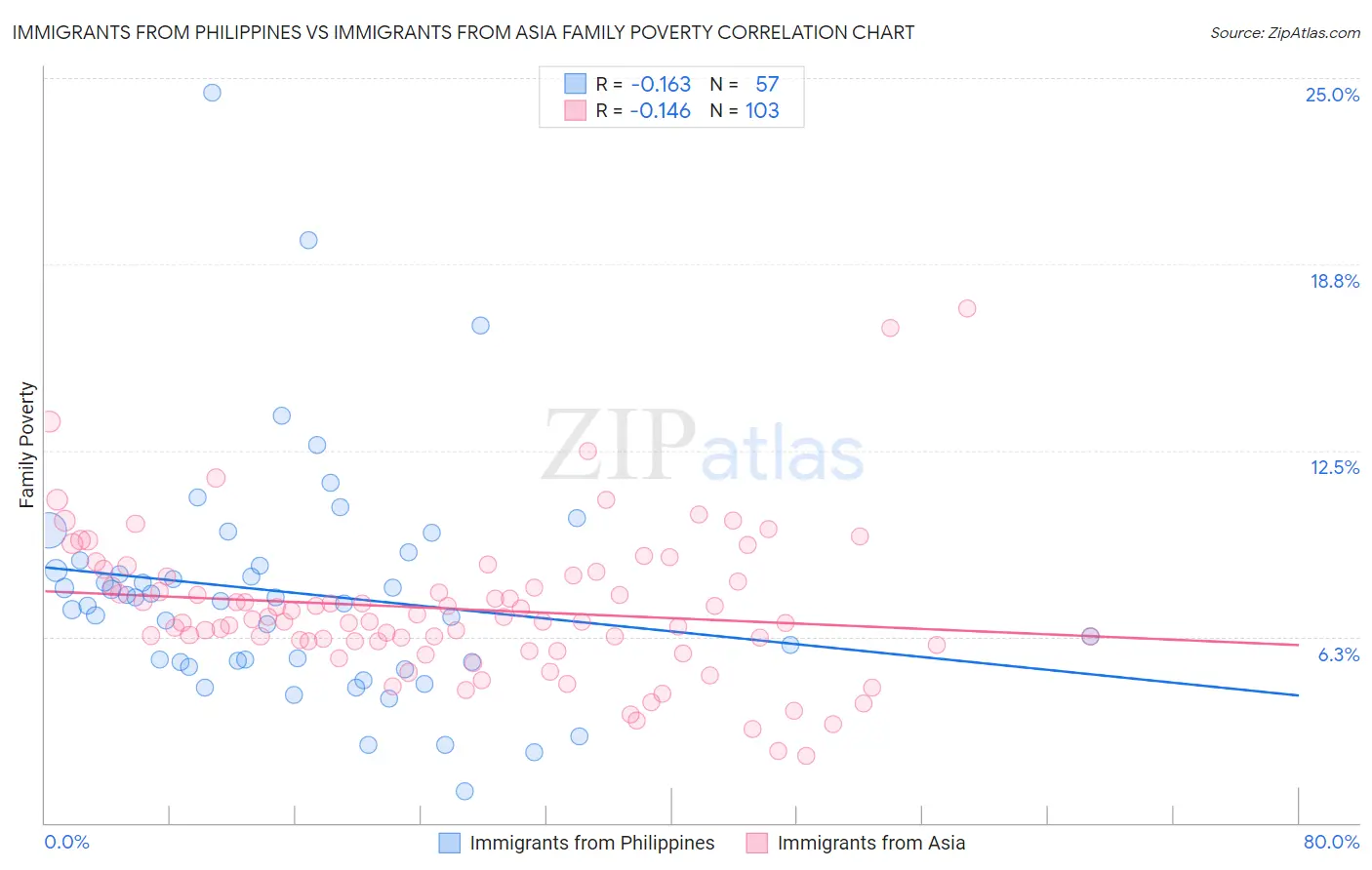Immigrants from Philippines vs Immigrants from Asia Family Poverty
COMPARE
Immigrants from Philippines
Immigrants from Asia
Family Poverty
Family Poverty Comparison
Immigrants from Philippines
Immigrants from Asia
8.0%
FAMILY POVERTY
96.5/ 100
METRIC RATING
95th/ 347
METRIC RANK
7.9%
FAMILY POVERTY
97.4/ 100
METRIC RATING
85th/ 347
METRIC RANK
Immigrants from Philippines vs Immigrants from Asia Family Poverty Correlation Chart
The statistical analysis conducted on geographies consisting of 469,729,486 people shows a poor negative correlation between the proportion of Immigrants from Philippines and poverty level among families in the United States with a correlation coefficient (R) of -0.163 and weighted average of 8.0%. Similarly, the statistical analysis conducted on geographies consisting of 545,488,463 people shows a poor negative correlation between the proportion of Immigrants from Asia and poverty level among families in the United States with a correlation coefficient (R) of -0.146 and weighted average of 7.9%, a difference of 1.1%.

Family Poverty Correlation Summary
| Measurement | Immigrants from Philippines | Immigrants from Asia |
| Minimum | 1.1% | 2.2% |
| Maximum | 24.5% | 17.3% |
| Range | 23.5% | 15.0% |
| Mean | 7.7% | 7.2% |
| Median | 7.4% | 6.8% |
| Interquartile 25% (IQ1) | 5.4% | 6.1% |
| Interquartile 75% (IQ3) | 8.7% | 8.3% |
| Interquartile Range (IQR) | 3.3% | 2.2% |
| Standard Deviation (Sample) | 4.0% | 2.5% |
| Standard Deviation (Population) | 3.9% | 2.5% |
Demographics Similar to Immigrants from Philippines and Immigrants from Asia by Family Poverty
In terms of family poverty, the demographic groups most similar to Immigrants from Philippines are Immigrants from Pakistan (8.0%, a difference of 0.010%), Immigrants from Turkey (8.0%, a difference of 0.020%), Tlingit-Haida (8.0%, a difference of 0.12%), Czechoslovakian (8.0%, a difference of 0.30%), and Immigrants from Switzerland (8.1%, a difference of 0.43%). Similarly, the demographic groups most similar to Immigrants from Asia are Scottish (7.9%, a difference of 0.040%), Belgian (8.0%, a difference of 0.13%), Serbian (8.0%, a difference of 0.20%), British (7.9%, a difference of 0.24%), and Immigrants from Denmark (8.0%, a difference of 0.34%).
| Demographics | Rating | Rank | Family Poverty |
| English | 97.8 /100 | #80 | Exceptional 7.9% |
| Irish | 97.8 /100 | #81 | Exceptional 7.9% |
| Immigrants | Poland | 97.8 /100 | #82 | Exceptional 7.9% |
| Slovaks | 97.7 /100 | #83 | Exceptional 7.9% |
| British | 97.5 /100 | #84 | Exceptional 7.9% |
| Immigrants | Asia | 97.4 /100 | #85 | Exceptional 7.9% |
| Scottish | 97.3 /100 | #86 | Exceptional 7.9% |
| Belgians | 97.3 /100 | #87 | Exceptional 8.0% |
| Serbians | 97.2 /100 | #88 | Exceptional 8.0% |
| Immigrants | Denmark | 97.1 /100 | #89 | Exceptional 8.0% |
| Immigrants | England | 97.1 /100 | #90 | Exceptional 8.0% |
| Immigrants | Italy | 97.0 /100 | #91 | Exceptional 8.0% |
| Czechoslovakians | 96.8 /100 | #92 | Exceptional 8.0% |
| Tlingit-Haida | 96.7 /100 | #93 | Exceptional 8.0% |
| Immigrants | Pakistan | 96.6 /100 | #94 | Exceptional 8.0% |
| Immigrants | Philippines | 96.5 /100 | #95 | Exceptional 8.0% |
| Immigrants | Turkey | 96.5 /100 | #96 | Exceptional 8.0% |
| Immigrants | Switzerland | 96.1 /100 | #97 | Exceptional 8.1% |
| Immigrants | South Africa | 95.9 /100 | #98 | Exceptional 8.1% |
| Welsh | 95.8 /100 | #99 | Exceptional 8.1% |
| New Zealanders | 95.8 /100 | #100 | Exceptional 8.1% |